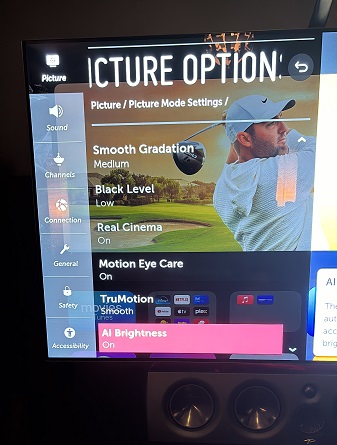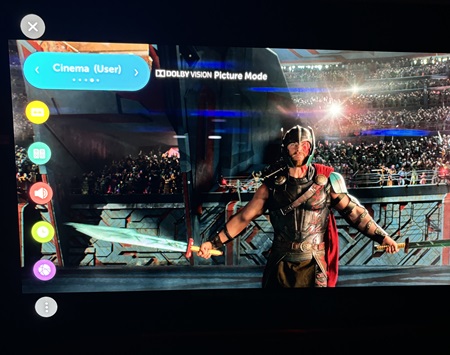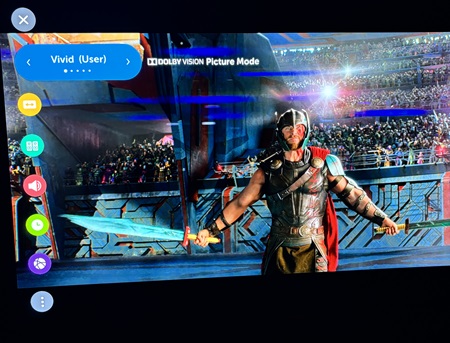I Turned On Vivid Mode For A Month So You Don’t Have To!
Many years ago, TVs were in Vivid Mode right of the box. After some lawsuits and standards around energy consumption, TVs no longer ship with the Vivid Mode standard. However, many folks default to it because it’s BRIGHT. Bright = better, right? Well, I turned on vivid mode for a month so you don’t have to! Did I survive? More importantly, did I notice a difference and did I keep it on? Let’s discuss.
The Test
The test was pretty simple. I navigated to the menu of my LG B9 OLED, chose Vivid mode, reset it to default, and then watched it for a month.


What did that mean in reality though? First, it maxed the OLED light, whereas I always have it set to 49%. Then, my LG B9 OLED turned on every bit of AI/Image processing, and whatever made my TV brighter. Lastly, brightness and contrast were increased to give the “sharpest” picture available.

The Results
As a surprise to no one, the images on my LG B9 OLED were brighter. I watch TV in a near-dark, light-controlled room, and any image lit up my room like a bonfire! Dolby Vision/HDR was like setting it to 11, and I may have done some damage to my retinas. I exaggerate of course. However, it was noticeably brighter with all content, whether it be SDR, HDR, movies, TV, or sports.

Colors, likewise, were more vivid, but not necessarily in a good way. I will be the first to admit that all the colors “popped” more on the screen. Movies like Guardians Of The Galaxy or Thor Ragnarok (which are drenched with vivid color palates) were over the top bright and saturated. Those vivid colors and increased contrast certainly looked pleasant…at first.


Unfortunately, the extra saturation and brightness turned the inky blacks and infinite contrast of my OLED washed out. Black scenes were now grey! That’s right folks! If you want to boost everything for the sake of brightness, color, and sharpness, you have to give up something. The black bars at the top of my letterbox image were suddenly greyish. Subtitles bloomed like I had never seen before.
Surprisingly, the thing I took the least offense to was the motion processing. My eye never got accustomed to the over-the-top brightness and extreme saturation of vivid mode. Yet, I did notice the smoothing less and less. Don’t think of that as an endorsement to use motion processing. There were absolutely moments where it was glaringly obvious that it was on. However, if you put a gun to my head and told me I had to live with one, motion processing would be the one I chose.
Why Do People Still Use Vivid Mode?
Objectively, the only time I see a use for vivid mode is in a very bright room. If your screen is bathed in direct sunlight and completely washed out. Or if you have a very old TV on its last legs and is getting dimmer, kill it with vivid. In both these cases, I would recommend you invest in some window treatments and get that room light controlled somehow.

Obviously, if you have an outdoor TV, vivid probably has a place. You aren’t using it for critical watching anyhow. TVs that are marketed for outdoor or commercial venues typically have insane brightness levels, and pricing to match.
The main reason is psychology. When we see something brighter, or with more vivid colors, we think it’s better. Why do we boost or bass after we run room correction? We like to feel that thump in our chest, even if we know it’s unrealistic.
Is There Any Harm In Using Vivid Mode?
Aside from the insult to all filmmakers out there, your TV could might may (?) get damaged from extended use of vivid mode. Both LED and OLED TVs have a lifespan, and over that span, they get dimmer. In the case of an LED TV, you are more likely to replace the TV due to obsolescence than noticeable dimming. My 12-year-old 37″ Samsung LED TV is finally showing signs of hot spotting and dimming. But only in direct sunlight!
OLED, in contrast, is organic, and will absolutely dim over time as the compounds wear out. Plus, with the OLED backlight set to maximum output, you are more likely to get burn-in from static logos on the screen. That said, long-term OLED Burn-In tests show that even under extreme circumstances, it’s unlikely if you vary your content once in a while.
The biggest harm is that the picture is not accurate, and that is what we enthusiasts strive for. It’s why we position our speakers properly, treat our rooms, run room correction, and endlessly tinker with our setups. To get THE BEST possible sound and image that we can.
Our Take
You’re welcome. I turned on vivid mode for a month so you don’t have to! However, I didn’t need to do it for a month to know it would be terrible. No, before you ask, I am not part of the Reddit Hive Mind. I do not have my TV calibrated to absolute perfection. I still use a “calibrated” eyeball to dial in my TV to my taste.
If vivid mode just made everything a little brighter, I would be all for it. However, it makes almost everything look unnatural. When you see a side-by-side, it’s clear which one is superior. So do yourself a favor and turn off vivid mode!
Oh, and did I keep vivid mode on? Oh heck no! Back to my accurate colors, please and thanks!


